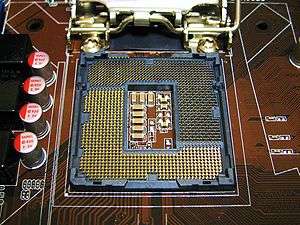LGA 1156
 | |
| Type | LGA |
|---|---|
| Chip form factors | Flip-chip land grid array |
| Contacts | 1156 |
| FSB protocol | PCIe 16× (video) + 4× (DMI) + 2 DP (FDI), 2 DDR3 channels |
| Processor dimensions | 37.5 × 37.5 mm[1] |
| Processors |
Intel Celeron Intel Pentium Intel Core i3 Intel Core i5 Intel Core i7 Intel Xeon |
| Predecessor | LGA 775 |
| Successor | LGA 1155 |
|
This article is part of the CPU socket series | |
LGA 1156, also known as Socket H[2][3] or H1, is an Intel desktop CPU socket. LGA stands for land grid array. Its incompatible successor is LGA 1155.
LGA 1156, along with LGA 1366, were designed to replace LGA 775. Whereas LGA 775 processors connect to a northbridge using the Front Side Bus, LGA 1156 processors integrate the features traditionally located on a northbridge within the processor itself. The LGA 1156 socket allows the following connections to be made from the processor to the rest of the system:
- PCI-Express 2.0 ×16 for communication with a graphics card. Some processors allow this connection to be divided into two ×8 lanes to connect two graphics cards. Some motherboard manufacturers use Nvidia's NF200 chip to allow even more graphics cards to be used.
- DMI for communication with the Platform Controller Hub (PCH). This consists of a PCI-Express 2.0 ×4 connection.
- FDI for communication with the PCH. This consists of two DisplayPort connections.
- Two memory channels for communication with DDR3 SDRAM. The clock speed of the memory that is supported will depend on the processor.
LGA 1156 socket and processors were discontinued sometime in 2012,[4] and superseded by the LGA 1155 socket. LGA 1366 was discontinued at the same time.
Supported processors
| Code name | Brand name | Model (list) | Frequency | Cores/Threads | Max Memory Speed |
|---|---|---|---|---|---|
| Lynnfield | Core i5 | i5-7xx | 2.66-2.8 GHz | 4/4 | DDR3-1333 |
| Core i7 | i7-8xx | 2.8-3.07 GHz | 4/8 | ||
| Xeon | L34xx | 1.86 GHz | 4/4 or 4/8 | ||
| X34xx | 2.4-3.07 GHz | ||||
| Clarkdale | Celeron | G1xxx | 2.26 GHz | 2/2 | DDR3-1066 |
| Pentium | G6xxx | 2.80 GHz | 2/2 | ||
| Core i3 | i3-5/9xx | 2.93-3.33 GHz | 2/4 | DDR3-1333 | |
| Core i5 | i5-6xx | 3.2-3.6 GHz | 2/4 |
All LGA 1156 processors and motherboards made to date are interoperable, making it possible to switch between a Celeron, Pentium, Core i3 or Core i5 with integrated graphics and a Core i5 or Core i7 without graphics. However, using a chip with integrated graphics on a P55 motherboard will (in addition to likely requiring a BIOS update) not allow use of the on-board graphics processor, and likewise, using a chip without integrated graphics on a H55, H57 or Q57 motherboard will not allow use of the motherboard's graphics ports.[5]
Supported chipsets
The Desktop chipsets that support LGA 1156 are Intel's H55, H57, P55, and Q57. Server chipsets supporting the socket are Intel's 3400, 3420 and 3450.
See also
- List of Intel microprocessors
- List of Intel Core i3 microprocessors
- List of Intel Core i5 microprocessors
- List of Intel Core i7 microprocessors
- List of Intel Pentium microprocessors
- List of Intel Celeron microprocessors
- List of Intel Xeon microprocessors
- Clarkdale (microprocessor)
- Lynnfield (microprocessor)
- LGA 775
- LGA 1366
- LGA 1155
References
- ↑ "Intel Core i5/i7 Datasheet" (PDF).
- ↑ Socket Transition Guidance
- ↑ Intel Core i7 & i5 Compatibility Sheet
- ↑ "Intel to discontinue LGA 1366 and LGA 1156 processors in 2012". December 8, 2011. Retrieved 2011-12-13.
- ↑ http://techreport.com/articles.x/18216/3
External links
| ||||||||||||||||||||||||||||||||||||||||||||||||